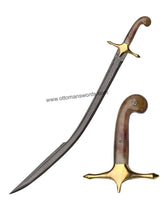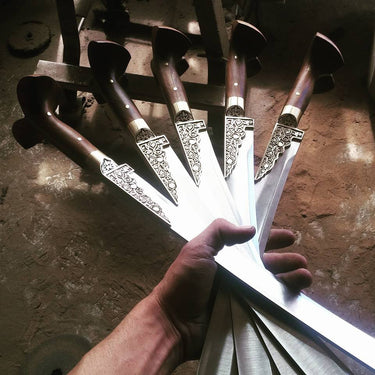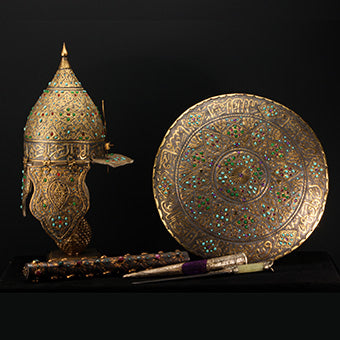10 Legendary Turkish Swords
The Turks, who migrated from Asia to Eurasia and Anatolia, deeply affected the sword shapes of the entire Middle East with the swords they brought with them. In the following periods, with the rise of the Ottoman Empire, it also affected Europe with the name of the Ottoman Sword.
It was precisely these swords that added strength to the Turks, helped the Ottomans to become the world emperor, and reached places that no one dreams could reach.
Kilij Swords

The First of the Legendary Turkish Swords Kilij!
The origin of Kilij, one of the most characteristic Turkish swords, goes back to the Asian Huns. The most important feature of this sword is that it has a very sharp impact and cutting power with its bend and leaning in the middle (the name given to the sharp area on both sides of the blade). In sharpness, it is one of the rare swords that can compete with the Katana. It is among the known rumors that he divided the enemy into two in one move. Click to Browse Swords
Agir Kilij Swords

The second of the Legendary Turkish Swords Agir Kilij!
The weight of the blade of this sword, which was found by the Turkic tribes in Central Asia, is quite heavy. Its deadliness as well as its weight is legendary, so it has taken on a form that is a mixture of sword and axe. This sword, which is quite scary in appearance, has also found a role in 300 Sparta films, but historically it belongs to the Turks before the Spartans. People who can use the sword closely, can even split the bullet in two. Click to Browse Agir Sword
Yatagan Swords

Third of Legendary Turkish Swords Yataghan!
Yatağan was widely used in the Ottoman period from the 16th to the 19th century; It is a famous and effective type of sword. Turkish Sword among foreigners, is also known as Kulaklı among the people. The center of gravity of the sword, its angle known as the Turkish curve in sword making and its ideal strike shape are different from other swords, so its use is difficult. The reason for this difference in form is to swing the enemy's sword blows from all directions more easily. But the power of destruction and chiseling in the hands of a good user is much higher than his contemporary swords. The motifs and writings in Yatağan are sometimes a poem and sometimes a quintessence, but mostly verses, the name of the owner of the sword, prayers and the date of production with the seal of the master who made the sword.
Click to Browse Yataghan Swords
Gaddare Swords

Fourth of Legendary Turkish Swords Gaddare!
This species, slightly shorter than the sword in form, is known for being extremely sharp. Gaddare, known to be controlled by two wires for being very heavy, was used by turning it over his head to break through the enemy front consisting of spear soldiers. Gaddare was carried on the shoulder or diagonally on the back with the pointed end pointed in the air while walking. Click Here To Check Out The Gaddare Swords
Shamshir Sword

Fifth of Legendary Turkish Swords Shamshir!
The origin of this curved sword goes back to the 9th century and Central Asia. Şemşir, which means sword in Persian, is worn horizontally on the waist unlike other swords. Typically, it is curved, tapering and tapering towards the tip. Its side view is reminiscent of the curl of a lion's tail. This sword focuses on cutting by spreading its impact energy across the blade. For this reason, it was used as a defensive weapon rather than an attack. Click to Browse Shamshir Swords
Karabela Swords

Sixth of Legendary Turkish Swords Karabela!
This sword of Ottoman origin was used by janissaries and sipahis. The most general distinguishing feature of Karabela is that its handle is shaped like an eagle head.
that is. It was adopted by Europeans due to the Ottoman's European expeditions, its convenience in use, lightness and military admiration for the Turks. Turks used it in the 17th and 18th centuries; In the following centuries it became popular by the Poles and became their official sword form.
Click to Browse Karabela Swords
Dimiski Swords

Seventh of Legendary Turkish Swords Dimiski (Damascus)
The name of the sword comes from Damaskus (Damascus), one of the strongest steels in the world. According to legends, it can split an opponent's sword and shield, or even a silk handkerchief left on the sword, in one shot. Dımışki swords owe their reputation largely to the Crusades. The stories told by the knights who encountered these swords on their expeditions to the Middle East when they returned to their countries, made Dımışki swords a legend in Europe over time. Click to Browse Damascus Swords
Mamluk Sword

Eighth of Legendary Turkish Swords Mamluk!
This sword, which has less curvature, is derived from the Mamluks who ruled Egypt in time. It is one of the oldest sword designs belonging to the Turkish-Islamic culture. It is thin, long, light and curved outward. It was gifted to the Americans by Hamit Bey from Karaman in the 19th century; Since then, it has been carried as a ceremonial sword by American naval officers. (cutting format) Click to Browse Mamluk Swords
Pala Sword

Ninth of Legendary Turkish Swords Pala!
While mostly janissaries use Yatağan; The machete was used by naval soldiers and cavalry. Machete, straight; it seemed to increase in width slightly towards the end and therefore slightly curved forward. It was used as a melee weapon because it was short and wide. Click to Browse Pala Swords
Dagger

Ten of the Legendary Turkish Swords / Dagger!
The ancient Turks hit the enemy with a dagger in the war and hand-to-hand combat. The cutter body is sometimes a single, but usually a double-edged cutting weapon. It has wide grooves as it is both a cutter and a melee weapon. Turkish daggers carried on a belt are approximately 35-40 cm. tall. The cutter body made of steel is decorated with gold or silver inlaid inscriptions, floral motifs, a bliss knot or Mühr-ü Süleyman. Its handles are bone, ivory, silver or gold plated. These are worn on wood in a velvet, leather, silver or gold-plated sheath. Click to Browse Daggers







